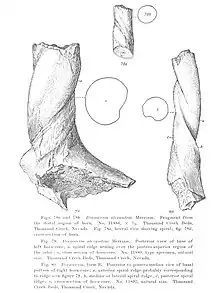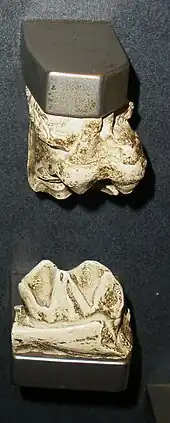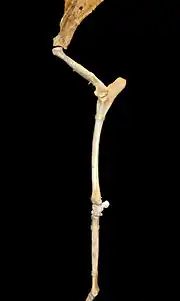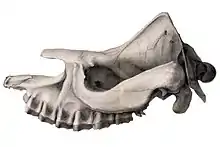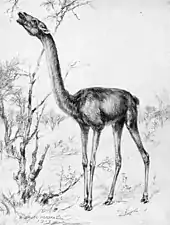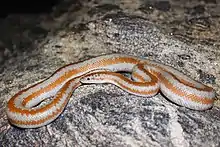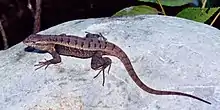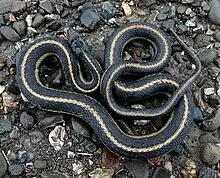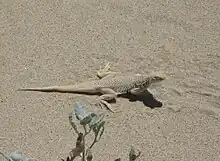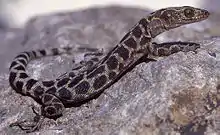Dove Spring Formation
The Dove Spring Formation (formerly the Ricardo Formation) is a geologic formation in the western Mojave Desert of California.[1] It preserves fossils dating back to the Miocene epoch of the Neogene period.
| Dove Spring Formation | |
|---|---|
| Stratigraphic range: Miocene ~[1] | |
| Type | Geological formation |
| Unit of | Ricardo Group[1] |
| Overlies | Cudahy Camp Formation[1] |
| Thickness | 1,800 meters[1] |
| Location | |
| Region | |
| Country | |
Fossil content
Color key
|
Notes Uncertain or tentative taxa are in small text; |
Bats
| Bats reported from the Dove Spring Formation | |||||
|---|---|---|---|---|---|
| Genus | Species | Presence | Material | Notes | Images |
| Chiroptera | Gen. et. sp. undetermined | Kern County, California.[1] | A bat. | ||
Carnivorans
Eulipotyphlans
| Eulipotyphlans reported from the Dove Spring Formation | |||||
|---|---|---|---|---|---|
| Genus | Species | Presence | Material | Notes | Images |
| Alluvisorex | A. chasseae | Kern County, California.[1] | A shrew. | ||
| Erinaceidae | Erinaceidae "A" | Kern County, California.[1] | An erinaceid. | ||
| Lanthanotherium | L. sp. | Kern County, California.[1] | An erinaceid. | ||
| Limnoecus | L. sp. | Kern County, California.[1] | A shrew. | ||
| Scapanus | S. (Xeroscapheus) shultzi | Kern County, California.[1] | A mole. | ||
| "Sorex" | "S." sp. | Kern County, California.[1] | A shrew. | ||
Lagomorphs
| Lagomorphs reported from the Dove Spring Formation | |||||
|---|---|---|---|---|---|
| Genus | Species | Presence | Material | Notes | Images |
| Hesperolagomys | H. sp. | Kern County, California.[1] | A pika. | ||
| Hypolagus | H. sp. | Kern County, California.[1] | A leporid. | 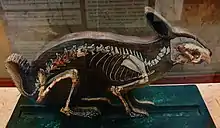 | |
Proboscideans
| Proboscideans reported from the Dove Spring Formation | |||||
|---|---|---|---|---|---|
| Genus | Species | Presence | Material | Notes | Images |
| Gomphotherium | G. sp. | Kern County, California.[1] | A gomphothere. | ||
| Serbelodon | S. burnhami | Ricardo, Kern County, California.[1][7] | Anterior portion of a mandible (F:AM 18228) & 2 tusk fragments (F:AM 18228A & 18228B).[7] | An amebelodontid. | |
Rodents
Ungulates
Birds
| Birds reported from the Dove Spring Formation | |||||
|---|---|---|---|---|---|
| Genus | Species | Presence | Material | Notes | Images |
| Branta | B. howardae | Kern County, California.[1] | A goose. | ||
| Neophrontops | N. ricardoensis | Kern County, California.[1] | A gypaetine vulture. | ||
Squamates
Testudines
| Testudines reported from the Dove Spring Formation | |||||
|---|---|---|---|---|---|
| Genus | Species | Presence | Material | Notes | Images |
| Clemmys | C. sp. | Kern County, California.[1] | An emydine turtle. | _(captive_specimen)_(36331198042).jpg.webp) | |
| Geochelone | G. sp. | Kern County, California.[1] | A tortoise. | ||
| ?Gopherus | ?G. sp. | Kern County, California.[1] | A gopher tortoise. | 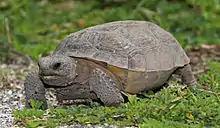 | |
Amphibians
| Amphibians reported from the Dove Spring Formation | |||||
|---|---|---|---|---|---|
| Genus | Species | Presence | Material | Notes | Images |
| Batrachoseps | B. sp. | Kern County, California.[1] | A lungless salamander. | ||
| Bufonidae | Kern County, California.[1] | A true toad. | |||
| cf. Ensatina | cf. E. sp. | Kern County, California.[1] | A lungless salamander. | ||
| Ranidae | Kern County, California.[1] | A true frog. | |||
Fish
| Fish reported from the Dove Spring Formation | |||||
|---|---|---|---|---|---|
| Genus | Species | Presence | Material | Notes | Images |
| Empetrichthys | E. sp. | Kern County, California.[1] | A splitfin. | ||
Plants
| Plants reported from the Dove Spring Formation | |||||
|---|---|---|---|---|---|
| Genus | Species | Presence | Material | Notes | Images |
| Acacia | A. sp. | Kern County, California.[1] | An acacia. | ||
| Ceanothus | C. sp. | Kern County, California.[1] | A buckbrush. | ||
| Cupressus | C. sp. | Kern County, California.[1] | A cypress tree. | ||
| Lycium | L. sp. | Kern County, California.[1] | A box thorn. | ||
| Palmoxylodon | P. mohavensis | Kern County, California.[1] | A palm. | ||
| Pinus | P. kelloggii | Kern County, California.[1] | A pine. | ||
| Quercus | Q. ricardensis | Kern County, California.[1] | An oak tree. | ||
| Robinia | R. alexanderi | Kern County, California.[1] | A legume. | ||
References
- Whistler, David P.; Burbank, D. (1992). "Miocene biostratigraphy and biochronology of the Dove Spring Formation, Mojave Desert, California, and characterization of the Clarendonian mammal age (late Miocene) in California". Geological Society of America Bulletin. 104 (6): 644–658. Bibcode:1992GSAB..104..644W. doi:10.1130/0016-7606(1992)104<0644:MBABOT>2.3.CO;2. S2CID 130575409.
- Tseng, Zhijie J.; Takeuchi, Gary T.; Wang, Xiaoming (2010-01-29). "Discovery of the upper dentition of Barbourofelis whitfordi (Nimravidae, Carnivora) and an evaluation of the genus in California". Journal of Vertebrate Paleontology. 30 (1): 244–254. doi:10.1080/02724630903416001. ISSN 0272-4634. S2CID 21713508.
- Wang, Xiaoming; Tedford, Richard H.; Taylor, Beryl E. (1999). "Phylogenetic systematics of the Borophaginae (Carnivora, Canidae)". Bulletin of the AMNH (243): 9–391. hdl:2246/1588.
- Hunt, Robert (1998-01-01). "Amphicyonidae". Mammalogy Papers: University of Nebraska State Museum: 196–227.
- Tedford, Richard H.; Wang, Xiaoming; Taylor, Beryl E. (2009). Phylogenetic systematics of the North American fossil Caninae (Carnivora, Canidae). (Bulletin of the American Museum of Natural History, no. 325). [New York] : American Museum of Natural History. hdl:2246/5999.
- Wang, Xiaoming; Whistler, David P.; Takeuchi, Gary T. (2005). "A New Basal Skunk Martinogale (Carnivora, Mephitinae) from Late Miocene Dove Spring Formation, California, and Origin of New World Mephitines". Journal of Vertebrate Paleontology. 25 (4): 936–949. doi:10.1671/0272-4634(2005)025[0936:ANBSMC]2.0.CO;2. ISSN 0272-4634. JSTOR 4524520. S2CID 21747985.
- Osborn, Henry Fairfield; Blick, John C.; Frick, Childs (June 1933). "Serbelodon burnhami, a new shovel-tusker from California". American Museum Novitates (639): 1–5. hdl:2246/2061.
- Thomas S. Kelly; David P. Whistler (2014). "New late Miocene (latest Clarendonian to early Hemphillian) cricetid rodents from the upper part of the Dove Spring Formation, Mojave Desert, California" (PDF). Paludicola. 10 (1): 1–48.
- Woodburne, Michael O. (2007). "Phyletic diversification of the Cormohipparion occidentale complex (Mammalia, Perissodactyla, Equidae), late Miocene, North America, and the origin of the Old World Hippotherium datum ; Bulletin of the American Museum of Natural History, no. 306". hdl:2246/5872.
{{cite journal}}: Cite journal requires|journal=(help) - Prothero, Donald R.; Foss, Scott E. (2007-12-17). The Evolution of Artiodactyls. JHU Press. p. 229. ISBN 978-0-8018-8735-2.
- Whistler, David P.; Wright, John W. (1989). "A Late Miocene Rear-Fanged Colubrid Snake from California with Comments on the Phylogeny of North American Snakes". Herpetologica. 45 (3): 350–367. ISSN 0018-0831. JSTOR 3892892.
- Scarpetta, Simon G. (2019-09-06). "The first known fossil Uma: ecological evolution and the origins of North American fringe-toed lizards". BMC Evolutionary Biology. 19 (1): 178. doi:10.1186/s12862-019-1501-5. ISSN 1471-2148. PMC 6729053. PMID 31492110.
- Various Contributors to the Paleobiology Database. "Fossilworks: Gateway to the Paleobiology Database". Retrieved 17 December 2021.
This article is issued from Wikipedia. The text is licensed under Creative Commons - Attribution - Sharealike. Additional terms may apply for the media files.



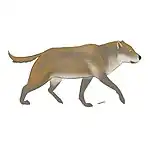
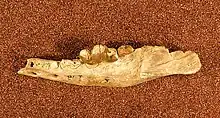

.jpg.webp)
